Land Invertebrates
Media
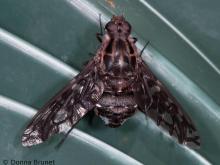
Species Types
Scientific Name
About 800 species in North America
Description
Resembling bees, or sometimes big, fuzzy mosquitoes, bee flies are a family of true flies and are not bees at all. Lacking the ability to sting, their bee mimicry helps them avoid many would-be predators.
Media
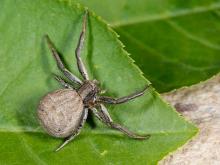
Species Types
Scientific Name
Xysticus spp.
Description
Missouri has several species of ground crab spiders in the genus Xysticus. They are usually dull gray or brown with brown, white, or yellow markings. They typically live under bark or on the ground in leaf litter.
Media
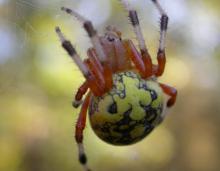
Species Types
Scientific Name
Araneus spp.
Description
Missouri's Araneus spiders, called angulate and roundshouldered orbweavers, can be hard to identify to species. Most have camouflage patterns, and they all make characteristic, delicate, wheel-shaped webs to catch prey.
Media

Species Types
Scientific Name
Neoscona spp.
Description
Missouri's Neoscona spiders, called spotted orbweavers, can be hard to identify to species. Most have camouflage patterns, and they all make the characteristic, delicate, wheel-shaped webs to catch prey.
Media

Species Types
Scientific Name
Various species in the order Pseudoscorpionida
Description
Pseudoscorpions are unusual little arachnids. They look something like tiny scorpions but with a rounded (and nonvenomous) hind end. They're common but often overlooked.
Media
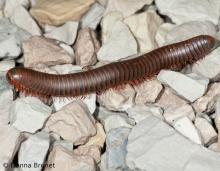
Species Types
Scientific Name
More than 900 species in North America north of Mexico
Description
Millipedes, which have two pairs of legs per body segment, are harmless detritus-eaters, move slowly, and curl up defensively when harassed.
Media

Species Types
Scientific Name
Loxosceles reclusa
Description
The brown recluse is a spider whose venomous bite may be medically significant to humans, though a bite is almost never fatal. Brown recluses are most commonly encountered in houses, where they occupy little-used drawers, closets, and other small hiding spaces.
Media
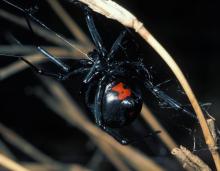
Species Types
Scientific Name
Latrodectus mactans and Latrodectus variolus
Description
The glossy, black-bodied female black widow spider has distinctive red spots on the underside of the abdomen. Only the female can inflict a potentially dangerous bite. The small, seldom-seen male is harmless.
Media
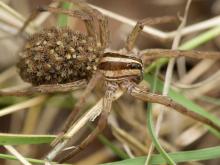
Species Types
Scientific Name
Nearly 250 species in North America north of Mexico
Description
A wolf spider doesn't spin webs to catch its prey — it runs it down like a wolf! Spiders in this family have long legs and are usually gray, brown, black, or tan with dark brown or black body markings (especially stripes).
Media
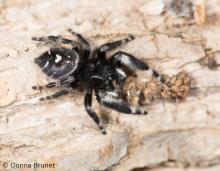
Species Types
Scientific Name
Phidippus audax
Description
The bold jumper, or white-spotted jumping spider, is fuzzy, makes jerky movements, jumps surprisingly long distances, and doesn't build webs. It usually has a black body with white, orange, or reddish spots on the abdomen.
See Also


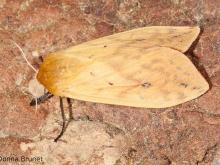
Media

Species Types
Scientific Name
Cisseps fulvicollis
Description
The yellow-collared scape moth is more often “orange-collared.” And whether you think it looks more like a firefly or a wasp, it’s still a moth!
Media

Species Types
Scientific Name
Nearly 150 species in North America north of Mexico
Description
Slim, delicate plume moths are instantly recognizable by their T-shaped silhouette, long legs, and muted shades of tan and brown. It can be hard to separate the various species.
Media

Species Types
Scientific Name
Pyrrharctia isabella
Description
Not many people know the adult Isabella tiger moth when they see one, but we’re all acquainted with its caterpillar, the woolly worm, or woolly bear.
About Land Invertebrates in Missouri
Invertebrates are animals without backbones, including earthworms, slugs, snails, and arthropods. Arthropods—invertebrates with “jointed legs” — are a group of invertebrates that includes crayfish, shrimp, millipedes, centipedes, mites, spiders, and insects. There may be as many as 10 million species of insects alive on earth today, and they probably constitute more than 90 percent all animal species.





















